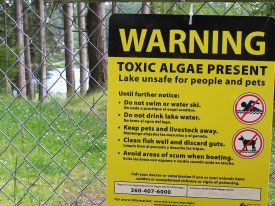by Joan Hardy, Washington Department of Health
 Has your lake experienced more algae blooms in recent years? You’re not alone. Washington is one of many states experiencing increased harmful algal blooms (HABs) in lakes, ponds, streams and rivers. Since HABs are an emerging public health issue, state and local health jurisdictions (LHJs) are concerned with toxic blooms, as are lake managers, lake residents, and those who use lakes for recreation. In Washington, liver toxins called microcystins are most prevalent; around 100 types are currently known. The next most frequently observed cyanotoxin in our state is anatoxin-a, a nerve toxin.
Has your lake experienced more algae blooms in recent years? You’re not alone. Washington is one of many states experiencing increased harmful algal blooms (HABs) in lakes, ponds, streams and rivers. Since HABs are an emerging public health issue, state and local health jurisdictions (LHJs) are concerned with toxic blooms, as are lake managers, lake residents, and those who use lakes for recreation. In Washington, liver toxins called microcystins are most prevalent; around 100 types are currently known. The next most frequently observed cyanotoxin in our state is anatoxin-a, a nerve toxin.
Each year, LHJs, the Washington Department of Ecology (Ecology) and the Washington Department of Health (Health) receive many requests to investigate animal and human illnesses associated with exposure to toxic blooms. Recently, the Centers for Disease Control and Prevention (CDC) developed a new national reporting system for tracking illnesses caused by HABs, called One Health Harmful Algae Blooms (OHHAB). In Washington, the first line of investigation remains the LHJ – there are 35 in our state. When an LHJ completes an investigation, they report conclusions to Health. If LHJs are not staffed to do a local investigation, a state epidemiologist may do so. Previously only an “outbreak” – defined as two or more human illnesses from a single lake — was reported nationally. With OHHAB, states can now report single cases of illness.
When there is a sick person or animal we’ll ask, “What lake was being used?” “When was the exposure?” “How many times were you/your pet in the water?” “What are the signs or symptoms?” “When did symptoms start?” State or local staff will try to match the exposure dates with water samples tested for toxicity; if samples weren’t taken during exposure, they will usually take one as soon as possible to determine whether cyanotoxins are present. Investigators will then determine whether the case is “not HAB-related,” “suspect” or “confirmed.” CDC has been working to define these categories as part of the OHHAB effort.
One of the problems with defining cases is that current methods confirming exposure to HABs, like blood or urine tests, can be hard to use because of logistical problems getting the samples as well as the short half-life in blood or rapid urinary excretion of most cyanotoxins. Interestingly, researchers at EPA Research Triangle Park in North Carolina are working on a biomarker for various HABs using hair or fur. Ecology has funded a Health project to collaborate with the researchers on biomarker development.
You can help! If you see an animal that may have died from exposure to a toxic bloom, take a fur sample (near the skin), place it in a sealed plastic bag, like a sandwich bag, and then alert your LHJ, Ecology, or Health. This will give EPA researchers in North Carolina a chance to test their methods on real world samples.
Find local health jurisdictions at http://www.doh.wa.gov/AboutUs/PublicHealthSystem/LocalHealthJurisdictions or call the Department of Health at (360) 236-3385 or Department of Ecology at (360) 407-6938.









